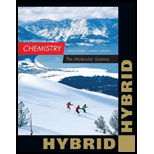
Concept explainers
Calculate the effective nuclear charge, Z*, on these electrons in a tin atom (a) 5s; (b) 5p; and (c) 4d.
(a)
Interpretation:
The effective nuclear charge on five s electrons in a tin atom has to be calculated.
Concept Introduction:
Calculation of effective nuclear charge:
The effective nuclear charge equation
Explanation of Solution
The electron configuration of tin is given by
There is no electron group to the right of the
(b)
Interpretation:
The effective nuclear charge on five p electrons in a tin atom has to be calculated.
Concept Introduction:
Refer to part a.
Explanation of Solution
The electron configuration of tin is given by
The electron is in the same group as
(c)
Interpretation:
The effective nuclear charge on four d electrons in a tin atom has to be calculated.
Concept Introduction:
Refer to part a.
Explanation of Solution
The electron configuration of tin is given by
There are four electrons in a group to the right of
Want to see more full solutions like this?
Chapter 5 Solutions
Chemistry: The Molecular Science, Hybrid Edition (with OWLv2 24-Months Printed Access Card)
- 5. Calculate the effective nuclear charge on a 5s, 5p, and 4d electron in a tin atom.arrow_forwardWhat is the energy of a photon in joules when an electron of Li2+ moves from orbit n=2 to n=1?arrow_forwardWhat is the energy, in J, of light that must be absorbed by a hydrogen atom to transition an electron from n = 3 to n = 6? Submit an answer to three significant figures.arrow_forward
- Calculate the most probable radius, rmp, at which an electron will be found when it occupies a 1s orbital of a hydrogenic atom of atomic number Z, and tabulate the values for the oneelectron species from H to Ne9+ .arrow_forward4. How do I write the complete electronic structure (1s2, 2s2, 2p6 etc.) of Polonium. -- write it in the proper order of filling based on the periodic table . **Without putting all subshells of one shell together.** Polonium Z = 84arrow_forwardWhat orbital has the quantum numbers n=4 I = 3, m1 = - 1?arrow_forward
- Which of the following is the electron configuration for zirconium (II) cation, Zr2+ (Z = 40)?arrow_forwardWhat is the energy, in J, of light that must be absorbed by a hydrogen atom to transition an electron from n = 3 to n = 5?arrow_forwardIf the experimentally determined Bi-I distance in bismuth triiodide is 2.81Å , predict the atomic radius of I?arrow_forward
- Strontium has a visible line in its spectrum at 539.8 nm. What is its energy in kJ/mol?arrow_forwardWhat is the kinetic energy of the emitted electrons when cesium is exposed to UV rays of frequency 1.90×1015Hz? Express your answer in joules to three significant figures.arrow_forwardQ.1(a) What were the important advance (s) as a result of which, idea of an electron orbitmovement was swapped by, the notion of probability of finding electron in an orbital?What name was given to the transformed atomic model? Also explain its variouspostulates.(b) Which quantum numbers revel information about the shape, energy, orientation, andsize of the orbitals? How many orbitals are possible for n=4? Which of these may bedescribed as gerade?(c) The signs of the unsquared wave functions are usually shown in plots of the squaredfunctions. Why do you think this practice exists? Give values of angular nodes andplane of 3p, 4d, 2p, 4f, 4s.(d) Predict the trend in values of slater’s constant of the every first element of each groupof p-block elements.arrow_forward
 Chemistry: The Molecular ScienceChemistryISBN:9781285199047Author:John W. Moore, Conrad L. StanitskiPublisher:Cengage Learning
Chemistry: The Molecular ScienceChemistryISBN:9781285199047Author:John W. Moore, Conrad L. StanitskiPublisher:Cengage Learning
